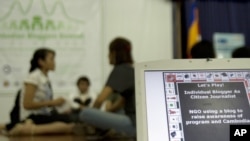The genocides in Cambodia and Rwanda were both aided by local media and propaganda, and the role of foreign media covering them is often criticized as insufficient.
In interviews with VOA Khmer, media experts said more funding of that sector could help prevent such errors in the future.
“I think in terms of investing in democracy, finding some ways to support a free press in a country like Cambodia is very important, actually, and this is one of the best investments you can make,” Michael Dobbs, a former journalist and senior adviser at the Center for the Prevention of Genocide, in Washington, said. “An independent media is one of the most important guarantees against absurd ethnic violence.”
Compliant media can be used to manipulate pubic opinion, he said. “I think that is very dangerous, in Cambodia and Rwanda and anywhere.”
Media development work can be carried out with funding from international donors and through international institutions, said Mark Nelson, at the National Endowment for Democracy. Rule of law, economics and democracy can all receive important influences through media, he said.
“I think now the media can help people understand what happened and to reflect on some of the mistakes that were made,” he said. “And I think it can be an important way of building a social cohesion and helping people to deal with things that happened in the past.”
Youk Chhang, head of the Documentation Center of Cambodia, said no foreign media were able to cover the atrocities of the Khmer Rouge. “Cambodia was closed, so the media only believed the propaganda of the Khmer Rouge from inside the country,” he said. “The Western media at that time did not publish about the Khmer Rouge, and it seemed like there were no killings at all.”
Some foreigners did visit Cambodia, escorted by members of Democratic Kampuchea, the official name of the regime, he said. “But they did not ask why Phnom Penh had no people, why people ate together, worked at sites together, why they had no place to stay.”
And even as the tragedy continued, public awareness declined, said Moeun Chhean Nariddh, director of the Cambodian Institute for Media Studies. Today, there seems little interest, even locally, he said. “Especially among the young, who don’t know about the genocide under the Khmer Rouge.”
The Khmer Rouge exaggerated their information as they wanted, inciting people to hate neighboring countries. “It wasn’t news at all,” he said. “Just propaganda that they played at construction sites or labor camps.”
There was no credible news, he said. “Being under the Khmer Rouge was like being a frog in a well, one that does not know what is happening in the outside world, that knows nothing.”
Cambodia needs more media training today, he said, and support is “essential.”
More Funding of Media a Good Investment, Experts Say
- Sok Khemara
- VOA Khmer

WASHINGTON DC —






